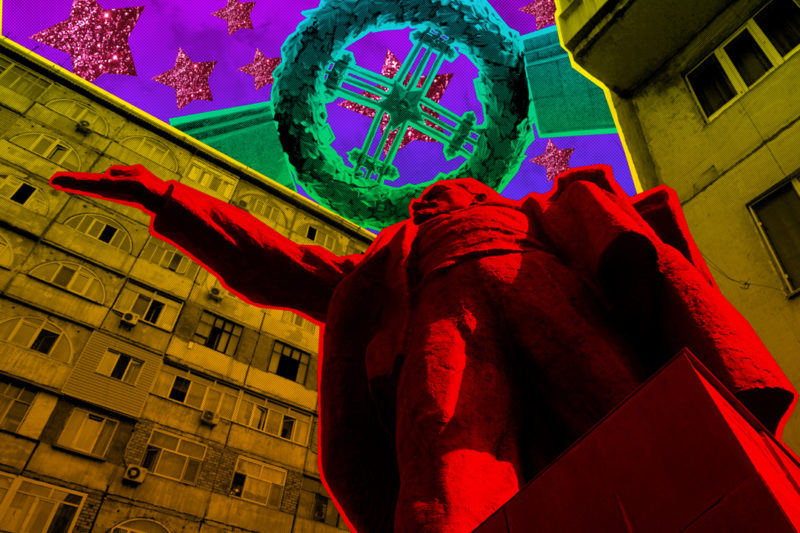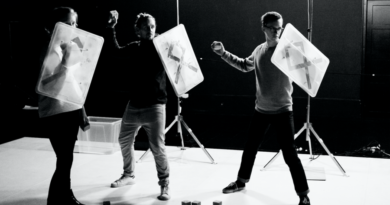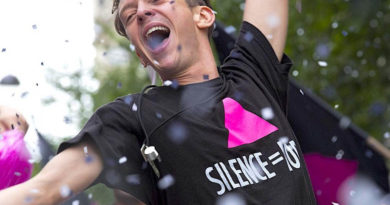Back to the Future with the Queer Communists of Kyrgyzstan
Meet STAB, the School of Theory and Activism Bishkek, and see how an energetic collective of radically creative minds can push the limits of the imagination in a place conventionally ignored as a post-Soviet backwater.
Text by Volodya Vagner
History is back, it seems. The indicators are many: coups are back in fashion in Turkey, war has made a comeback in Europe, and outright racists – as well as socialists – running for president is a thing again in the US. Gone are the post-historical 90s, when progress in the form of enlightened, liberal capitalism was to finally take over the world, and the appearance of contemporary art in the new East and rising South was heralded as a first sign of its taking hold there. This is the 2016, and post-history is a thing of the past.
If history is back, does that mean utopia is too? Is there once more room for a radical reimagining of the future? Can artistic production still afford to remain unambitiously apolitical? You might be surprised to learn that there are people, not in Brooklyn or Berlin, but in Bishkek, the capital of the small Central Asian republic of Kyrgyzstan, who are working out answers to these questions. And they are loud and clear: “THE BUILDING OF THE FUTURE IS TO BE CONSTRUCTED OUT OF THE BUILDING BLOCKS OF THE PRESENT, and current imaginations, practices and experiences, which radically contradict dominant normativity, constitute such building blocks” – or so declares a passage in their manifesto.
Meet STAB – the School of Theory and Activism Bishkek. “We can’t imagine doing this anywhere else”, Georgy Mamedov, one of the minds behind this hybrid between think tank, art collective and activist group explains. “We were born and raised in Central Asia, why would we go elsewhere?” His associate Oksana Shatalova nods. “Yes, and Bishkek is by far the most vibrant place in the region”, she adds.
In stark contrast to the dictatorships surrounding it, Kyrgyzstan was long paraded as an example for successful transition from Soviet backwardness to liberal post-modernity. Fairly democratic, open to foreign investors, and with a pluralist civil society, Western observers dubbed it “the Switzerland of Central Asia”. Reminders of the socialist past, like monuments to Lenin, were but some residual optical illusion, slowly fading from public space.
Here too, though, history has returned, and STAB is at its forefront. As the rest of the world is trying to come to grips with facing an unknown future again, the group is artistically and intellectually capitalizing on the forgotten remnants of the great promises of the Soviet past. Many of the group’s projects can be characterized as attempts to unearth the avant-garde futurisms of the failed communist experiment. In guided tours with titles like “Utopian History of Bishkek” and “Fragmented Dream”, participants are taken to revisit some of the city’s decaying constructivist architecture and monumental mosaics depicting emancipated workers – decades-old tributes to a future that never materialized.
However, STAB’s point is not simply to recycle socialist iconography. “The Soviet as such isn’t what we’re interested in. Rather, it’s what that experience means for progressive politics today”, Georgy clarifies. The collective made this point confidently in 2013 when they published the Queer Communist Manifesto, in which they clearly distinguished themselves from conservatives nostalgic for the good old Soviet days. “Queer for us is a central and complex thing. It symbolizes all oppressed forms of corporeality, generally ignored by the classic Left, including but not limited to, LGBT corporeality”, Georgy says. Accordingly it is not only the official but also the subaltern history of the Soviet era that STAB revisits. In 2015 they produced a film called, Queer in Space: Kollontai Commune Archive, which tells the story of “a mysterious gender dissidents collective” that is said to have existed in the city in the 70s.
In this, queerness is more than a theoretical positioning for STAB. Part of what’s unique about the group is the eclectic nature of its practices. “We call it the Queer Method”, Oksana explains. “If you can expand the queer approach beyond the realm of sexuality and into other fields of identity – why not to our professional endeavors as well?”. It is this Queer Method which blurs the lines between political activism, theoretical production and artistic creation.
“Activism is something we do in the sense of supporting existing initiatives or responding to acute issues”, says Georgy. “Theory,” he continues, “understood in the sense of constant critical reflection, is what structures all our activity. Art is the language we express ourselves through.”
What ties this activism-theory-art bundle together is an ambition to politicize experience and serve a greater purpose. “Public Service Art”, they call it somewhat tongue in cheek. Its results come in various forms: In 2012 STAB organized a 2-week workshop titled Beat Homophobia with the Art’s Wedge with the LGBT advocacy group Labrys, in which participants could practice their skills in “unalienating protest”, designing anti-homophobic protest material. In 2013 they produced a cartoon booklet called Join the Union! for Kyrgyzstan’s Miners’ and Metalworkers’ Union.
Excitingly, STAB has in recent months pursued an ever more future-oriented trajectory. In June Berlin-based artist Nika Dubrovsky gave a guest lecture on her own work, the food of the future. Her project can be described as a vision of a DIY-Star-Trek-Communism, in which we all replicate our own nutrition by way of 3D-printers and home-grown spirulina. In a spirit much akin to STAB’s, her work is clearly inspired not only by official Soviet discourse and its enthusiasm for harnessing the power of technology, but also by the ingenuous capacity for improvisation and innovation under conditions of scarcity, which was the essence of the average Homo Sovieticus. STAB’s next project will be a series of events called Against Nature: Queer, SciFi, Art. The future is back with a vengeance, it seems.


